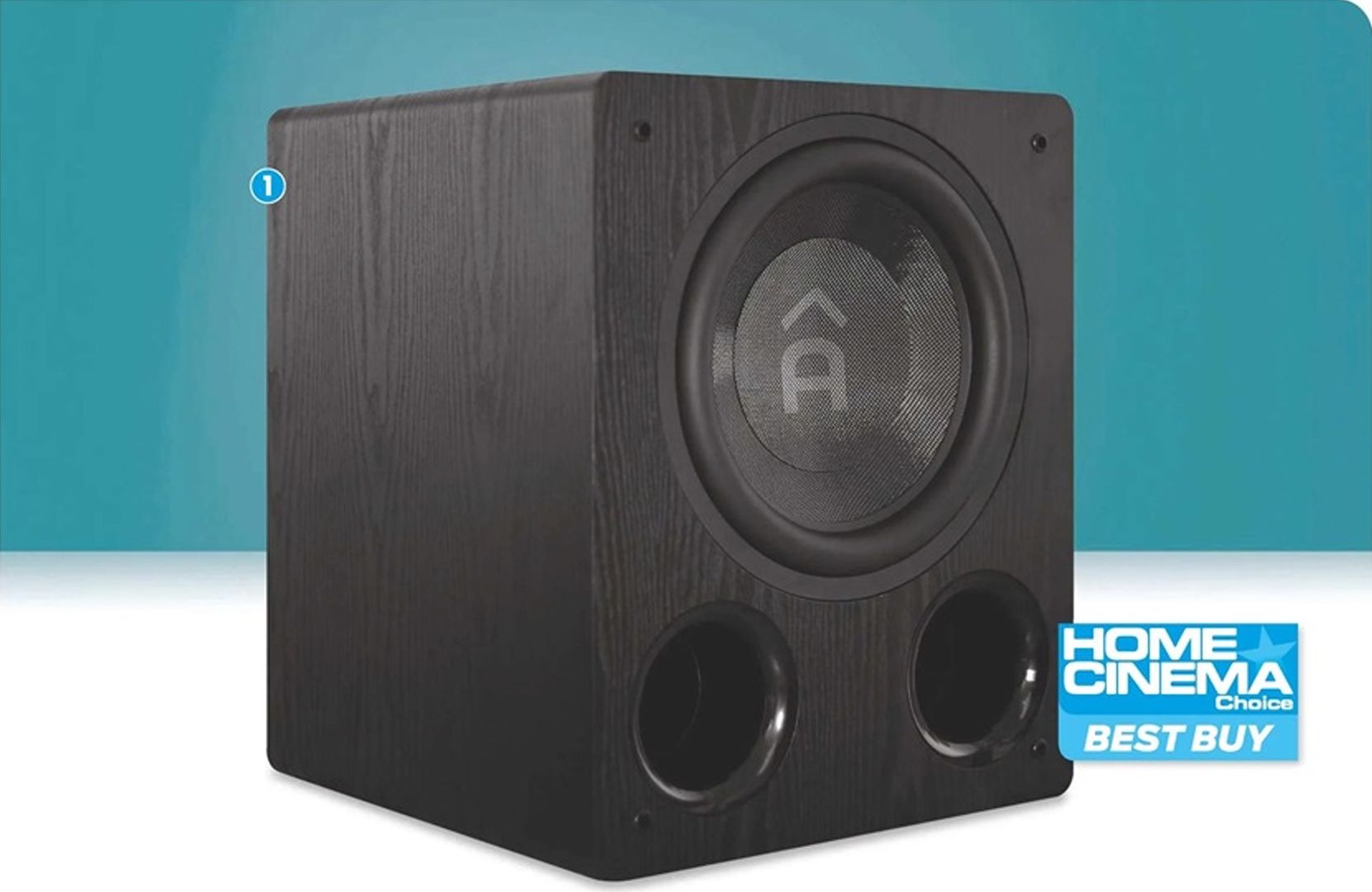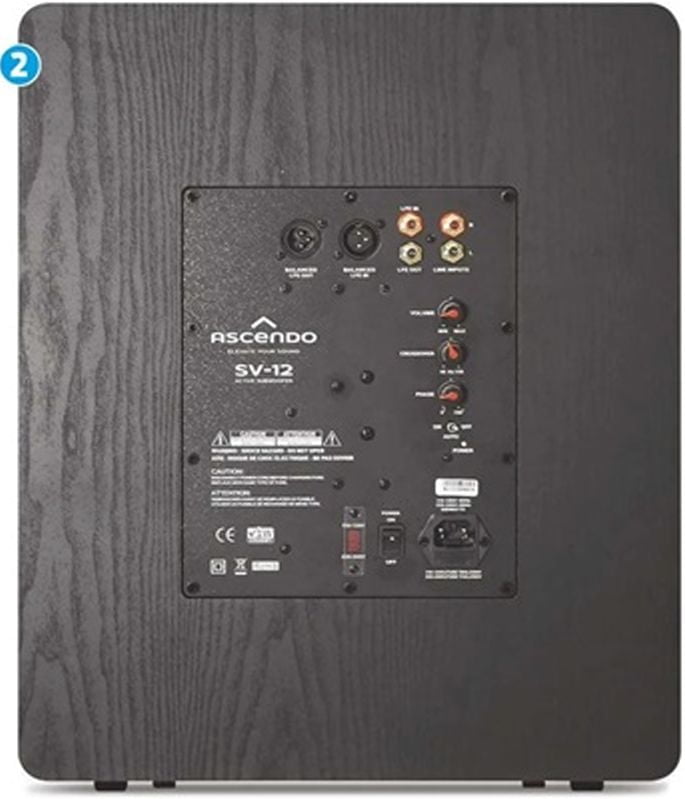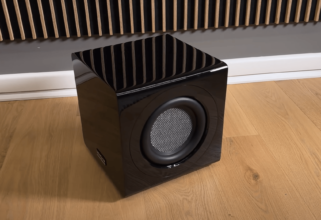Ascendo sv-12 Review: Sweet and lowdown
With its 12in driver and ported cabinet, the SV-12 might be considered a large design by some – but it’s actually Ascendo’s smallest subwoofer. Richard Stevenson investigates. Read our Ascendo sv-12 Review.

1. Ascendo adds its logo to the custom-made 12in driver
AV INFO
| Product | 12in ported active subwoofer |
| Position | The baby of Ascendo’s expansive lineup of active/ passive woofers |
| Peers | Monitor Audio Silver W-12; Klipsch SPL-150 |
| Website | www.aia-cinema.com |
ASCENDO IS A German high-end speaker manufacturer that has been rocking some serious and occasionally bonkers designs since 1999. From sane and sensible beginnings with sub/sat speaker arrays and subsequently its own Room Tools EQ software, the company has continued to push the envelope of speaker design, often with a bulldozer. The fully active. DSP-controlled, LED-illuminated Ascendo Live 15 speakers kicked out one of the very best sounds of the Munich High End show a couple of years ago (in my humble opinion), and the brand has recently built upon its bonkers SMSG50 50in subwoofer with, well, 30 more inches.
Yes. Ascendo’s new The 80 SUB features an 80in driver and a 10.000W amplifier in a custom enclosure, dips to – apparently – 1Hz and hits peak sound pressure levels of over 145dB. Sadly, one wasn’t available for review, so we got in Ascendo’s SV-12 instead. This is the smallest active subwoofer in the German brand’s range. Do I look like the kid who saw the entire candy store and then got given a carrot? Yes. yes I do.
Yet the SV-12 is an interesting design and is far from compact or bijou when compared to other subs at this price point in the UK. At 40cm wide. 40cm deep and 48cm tall, it is quite a beast and the design language is very much ‘in-yer-face’. The big 12in driver has a woven fibre surface and continuous profile phase plug with the Ascendo ‘A’ printed at the centre. Subtle… not.
This is Ascendo’s own driver design, featuring a sandwich composite cone to tick off the light/stiff requirements and a huge rubber roll surround to afford serious excursion.
Where’s Tiddies?
There is no having to guess if this is a sealed or vented enclosure either, as you get two front-mounted ports big enough to lose the cat in. Deep port tubes extend into the cabinet, said to keep fundamental tuning at key LFE frequencies and port chuffing to a minimum.
- 7Review earns Amazon affiliate commissions from qualifying purchases.
The cabinet is a braced MDF box with a black wood-textured vinyl wrap, the only aesthetic design feature of note being the lightly radiused corners on the front to back edges. While its 22kg is no lightweight, it’s not the heftiest cabinet I’ve lifted with these sorts of dimensions. If you want to hide the aggressive front-end visuals, you get a black grille that fits on traditional post-and-plug mounts.
The electronics plate mounted flush into the rear panel is also relatively svelte compared to the size of the cabinet yet hides a 500W Class D amp. Connectivity options include both RCA and XLR-based LFE inputs, complete with loop outputs for adding more subs, and RCA stereo line-level. You get rotary controls for gain. 40Hz-150Hz crossover, and variable phase from 0-180 degrees. High-level inputs might have been nice for two-channel setups, but Ascendo specifically refer to this as a Home Theatre Subwoofer, and you can’t knock dedication to the task.
There’s no room EQ. no remote control and no smartphone/tablet app: just auto power on/off and a claimed LF response down to 25Hz. While that is not the lowest claim seen for a subwoofer with a 12in driver, it’s fairly realistic for this size of ported cabinet and plenty low enough for serious LFE fun.
Listen, tweak, listen
Hooked up to my Marantz processor via both RCA and XLR. the SV-12 was blissfully hum-free, and even connecting a stereo amplifier via the line-level RCAs simultaneously didn’t create the bee-hive ground loop I feared. Setup involves placement and phase being dialled in through experimentation and listening, assuming your back and ears are up to the task.
My first installation involved corner placement, zero degree phase adjustment, and a mid-level gain setting that was then adjusted to balance with the main speakers using the attenuation available in the Marantz processor’s menus. That provided a sweet sound at normal ‘day-to-day’ listening volumes, with regular broadcast TV content such as Happy Valley (BBC One) nicely underpinned with additional bass weight and authority.
Yet switching to John Wick on Blu-ray had me leaping up and frantically tweaking the gain control as the film’s gung-ho LFE threatened to turn my eardrums into paper mache. Ascendo’s 12in driver certainly doesn’t lack output or clout! The additional boundary gain from the corner position seemed to hook up with those big front ports spectacularly well, but I needed a little more finesse and control.
Some experimentation later, the SV-12 ended up off to one side of the screen wall, the gain level reduced and the phase adjusted to a handful of degrees off zero – perhaps accounting for my in-wall main speakers being some 50cm further away from the listening position than the sub. Like AV alchemy, the resulting sound felt much more than the sum of the parts.

2. The SV-12 has LFE inputs/outputs on both RCA and XLR, plus stereo RCA line in
With Marantz’s bass management set to LFE+Main. the SV-12 added richness to dialogue and a weightier, more solidifying ambience to scenes overall. The steam train fight scene in Enola Holmes (Netflix) was delivered with added urgency and authority as the enveloping sound of the locomotive added to the drama.
Happy that the subwoofer’s in-room position, gain, balance and phase were better harmonised with my main speakers, a re-run of John Wick saw the SV-12 back in the game. The assault on Wick’s home is a festival of gunshots and high-speed camera pans, mostly in the dark to let the sound do the talking. With Ascendo’s subwoofer on duty, the LFE elements offered both superb scale and a tight, percussive edge that larger vented enclosure subs can sometimes struggle to attain. The SV-12 rocked and rolled with unburstable energy through to the end of the scene, where Wick asks the cop: ‘noise complaint?1 Yes. you could say that.
All-action Ascendo
I developed a real soft spot for Ascendo’s SV-12 during my time with it. While it is bereft of the tech features available even on subwoofers that sell for less, and is fundamentally a basic ‘big-driver-in-big-ported-cabinet’ design, it offers far more agility and punch with high-volume LFE crescendos than you might expect – presumably thanks to clever port tuning, well-engineered cabinet bracing and effective electronics. If you were using it to underpin stereo loudspeakers, you might prefer it to be more tuneful and less peaky on some frequencies but. as Ascendo says, this is a Home Theatre Subwoofer, and for that task it delivers LFE in all-action spadefuls.
Verdict
SPECIFICATIONS
| DRIVERS: | 12in composite sandwich cone woofer |
| ONBOARD POWER (CLAIMED): | 500W Class D amplifier |
| ENCLOSURE: | Twin front-ported |
| FREQUENCY RESPONSE (CLAIMED): | 25Hz-150Hz |
| REMOTE CONTROL: | No |
| DIMENSIONS: | 400(w) x 480(h) x 400(d)mm |
| WEIGHT: | 22kg |
| FEATURES: | XLR balanced and RCA LFE input; XLR/RCA loop-out; line-level stereo RCA input; variable 0 to 180 degrees phase; 40Hz-150Hz crossover control; auto power off/on; supplied with grille |
TESTED WITH
JOHN WICK: A seminal action film for LFE testing, with a plot demanding you leave both your disbelief and any breakable objects firmly at the door. An Atmos mix graces both Blu-ray and 4K BD incarnations, and it’s a riot of explosions, gun-shots, large-engine cars and ambient street scenes, creating an audio cornucopia.






